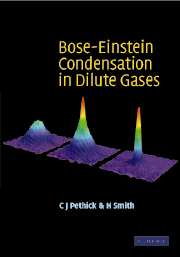Book contents
- Frontmatter
- Contents
- Preface
- 1 Introduction
- 2 The non-interacting Bose gas
- 3 Atomic properties
- 4 Trapping and cooling of atoms
- 5 Interactions between atoms
- 6 Theory of the condensed state
- 7 Dynamics of the condensate
- 8 Microscopic theory of the Bose gas
- 9 Rotating condensates
- 10 Superfluidity
- 11 Trapped clouds at non-zero temperature
- 12 Mixtures and spinor condensates
- 13 Interference and correlations
- 14 Fermions
- Appendix. Fundamental constants and conversion factors
- Index
4 - Trapping and cooling of atoms
Published online by Cambridge University Press: 06 July 2010
- Frontmatter
- Contents
- Preface
- 1 Introduction
- 2 The non-interacting Bose gas
- 3 Atomic properties
- 4 Trapping and cooling of atoms
- 5 Interactions between atoms
- 6 Theory of the condensed state
- 7 Dynamics of the condensate
- 8 Microscopic theory of the Bose gas
- 9 Rotating condensates
- 10 Superfluidity
- 11 Trapped clouds at non-zero temperature
- 12 Mixtures and spinor condensates
- 13 Interference and correlations
- 14 Fermions
- Appendix. Fundamental constants and conversion factors
- Index
Summary
The advent of the laser opened the way to the development of powerful new methods for manipulating and cooling atoms which were exploited in the realization of Bose–Einstein condensation in alkali atom vapours. To set the stage we describe a typical experiment, which is shown schematically in Fig. 4.1. A beam of sodium atoms emerges from an oven at a temperature of about 600 K, corresponding to a speed of about 800 m s–1, and is then passed through a so-called Zeeman slower, in which the velocity of the atoms is reduced to about 30 m s–1, corresponding to a temperature of about 1 K. In the Zeeman slower, a laser beam propagates in the direction opposite that of the atomic beam, and the radiation force produced by absorption of photons retards the atoms. Due to the Doppler effect, the frequency of the atomic transition in the laboratory frame is not generally constant, since the atomic velocity varies. However, by applying an inhomogeneous magnetic field designed so that the Doppler and Zeeman effects cancel, the frequency of the transition in the rest frame of the atom may be held fixed. On emerging from the Zeeman slower the atoms are slow enough to be captured by a magneto-optical trap (MOT), where they are further cooled by interactions with laser light to temperatures of order 100 μK. Another way of compensating for the changing Doppler shift is to increase the laser frequency in time, which is referred to as ‘chirping’. In other experiments the MOT is filled by transferring atoms from a second MOT where atoms are captured directly from the vapour.
- Type
- Chapter
- Information
- Bose–Einstein Condensation in Dilute Gases , pp. 58 - 101Publisher: Cambridge University PressPrint publication year: 2001



